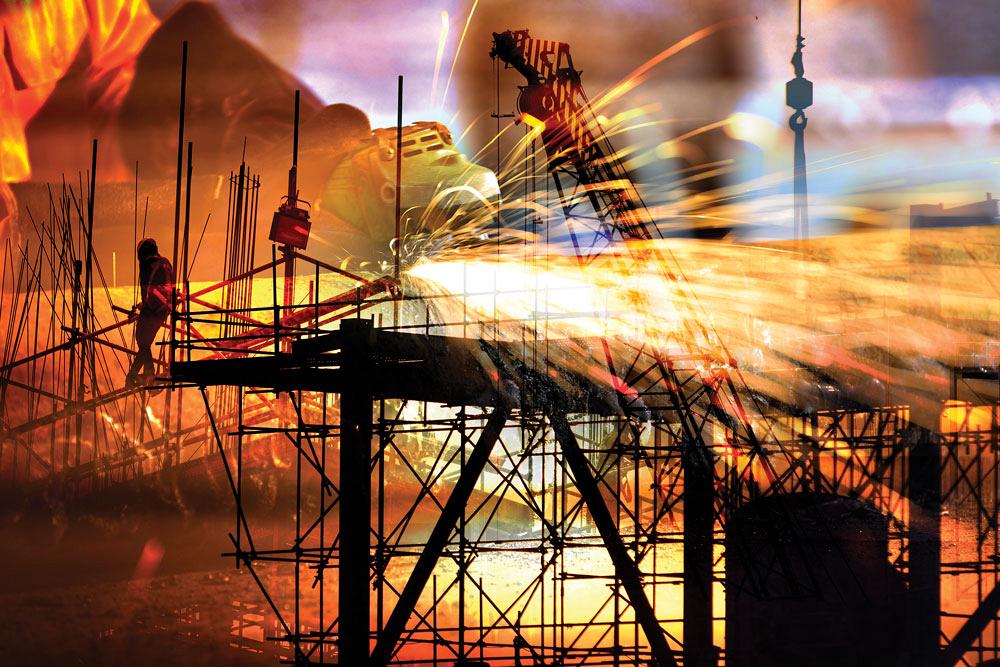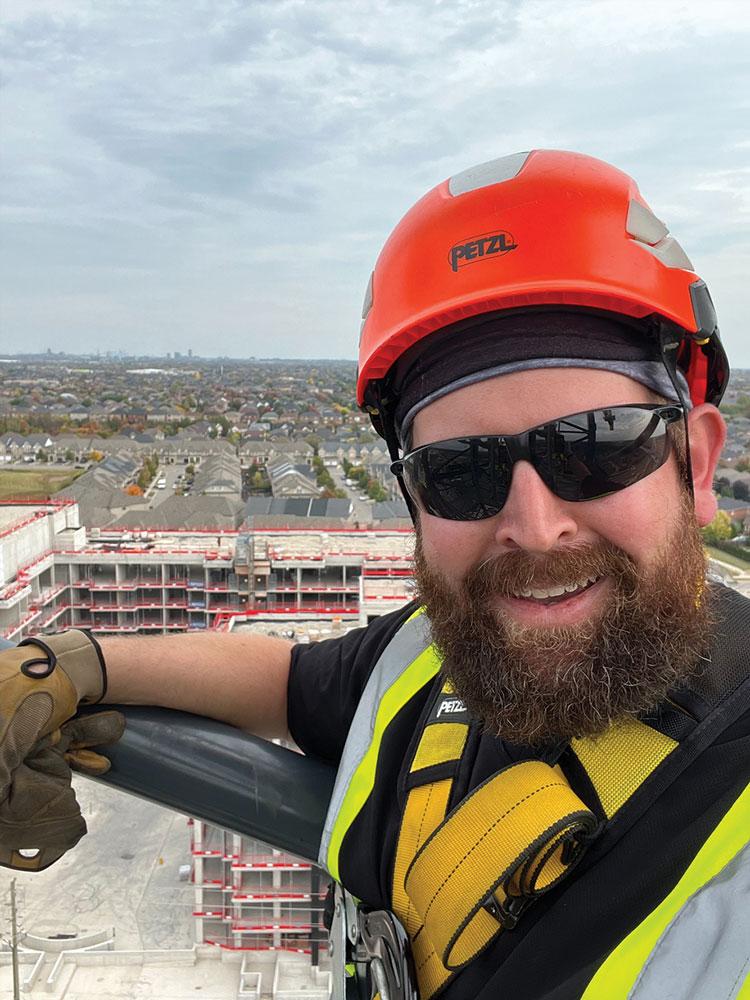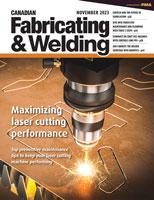Associate Editor
- FMA
- The Fabricator
- FABTECH
- Canadian Metalworking
Eliminate the risks of falling from heights
Regulations outline fall prevention requirements to ensure workers’ safety
- By Lindsay Luminoso
- January 8, 2024
- Article
- Health & Safety

Fall protection needs to be considered any time there is a risk of falling from heights greater than 10 ft., or if there’s an unusual risk of injury at heights less than 10 ft. Phonix_a/iStock/Getty Images Plus
Every jurisdiction in Canada has regulations governing health and safety in the workplace. And when it comes to fabricating and welding, components can come in all shapes and sizes. A welder that needs to access the top of a 20-ft. component or is working on the roof at a mobile site will be working from heights and increasing his or her fall risk. However, there are some common principles that help ensure that workers are kept safe at heights.
Follow Regulations
“Any time there is a risk of falling greater than 10 ft., or if at heights less than 10 ft. there's an unusual risk of injury, fall protection needs to be considered,” said Barry Nakahara, senior manager of prevention field services, WorkSafeBC, Vancouver. “For example, if there is the potential for a worker to fall on a non-flat surface from anything less than 10 ft., there is an elevated risk of injury, so prevention and protective equipment may be needed.”
Regulations clearly state what situations warrant fall protection and what type of protection is required.
“It’s not just an arbitrarily drawn line,” said Douglas Legg, service and training manager, Rubicon Safety, Burlington, Ont. “The rules are explicit and anyone in the health and safety world knows exactly why they are written. In a way, they are a culmination of accidents and incidents that have occurred, and that the industry has learned from.”
A good starting point for information related to legislation is the Canadian Centre for Occupational Health and Safety website: www.ccohs.ca
Each jurisdiction has slightly different rules for the level of health and safety representation needed. For example, in both Ontario and B.C., any workplace with 20 or more employees needs to have a joint health and safety committee to support the employer's duty to ensure a healthy and safe workplace.
In workplaces with less than 20 people—more than six in Ontario and more than nine in B.C.—a health and safety representative is required. This person should come from within the company and needs specific training to be the representative.
For small shops with only a handful of employees—the number depends on the jurisdiction—it is the employer’s responsibility to understand and implement regulations.
Do Your Due Diligence
Without constant attention and due diligence, many employers may not know when rules and regulations are updated or when new mechanisms need to be put in place.
“The rules are based off of occupational health and safety acts that more of our employers need to spend time reading, reviewing, interpreting, and applying inside their workplaces,” said Legg. “The tone should always come back to the thought of due diligence. If you are a business owner or a supervisor, you have to be asking yourself, ‘Am I doing everything within my power to protect my workforce?’ If you see an area where somebody could fall into a piece of operating machinery or onto a hazardous substance, you are responsible to provide some sort of safety mechanism or guard to segregate the hazard.”

Be mindful of the surroundings and take every reasonable precaution. It's all about identifying specific areas of concern and applying what would be the best fall prevention system. Rubicon Safety
Shop personnel should be mindful of their surroundings and take every reasonable precaution. They also should consider the worst-case scenarios that the shop floor presents and the best ways to mitigate these issues.
“Depending on the nature of work in the shop, doing a safety assessment might be needed every day or even every hour,” said Nakahara. “For others, it might be just on occasion where they get equipment in or an order in that puts workers in positions where the fall protection would be required. For shops where the work is very dynamic, there tends to be ever changing hazards and risks and at times there may be few and others many. Employers need to recognize the nature of business and understand the level of due diligence needed.”
Audit the Work Zone
For manufacturers that just don’t have the expertise or time to perform an effective assessment, brining in a specialist can help.
“Hire a safety specialist to audit the facility or apply safety regulations to existing shop floor hazards,” said Legg. “If you are unsure about where you are in terms of health and safety or questioning if you can do more, chances are you probably can do more. Be humble and contact a safety consultant in the world of health and safety, someone with the background and knowledge to build an action plan.”
Assessing the work zone to determine potential safety hazards is the most basic starting point. Assess or have someone assess the work zone and determine potential hazards. It can be challenging for any manager to know all the ins and outs of the day-to-day work, so hiring someone with an objective view to perform the assessment and make honest safety recommendations is the key to success.
Understand the Hierarchy of Controls
Not all work environments are created equal, which is why there is a hierarchy of controls to ensure workplace safety as it relates to fall protection. In traditional safety hierarchy, it is preferrable to eliminate the hazard or risk altogether by not putting a worker at a height.
“When that is unavoidable, which can often be the case, regulation dictates fall protection mechanisms that prevent a worker from falling,” said Nakahara. “Work platforms or scaffolding with guardrails, for example, will help prevent a worker from falling. In the event that this is not feasible or practical, regulations allow for fall arrest systems. These will not prevent you from falling, but would catch you in a fall. This is your typical harness or lanyard, where the lifeline anchor is affixed to an appropriate point.”
There are different levels of fall protection. Ideally, manufacturers should start with the highest or the most reliable control that is available.
Make Workspace Adjustments
To effectively control the fall hazards or the fall risk, shops must first think about the risk factors found on the shop floor or worksite.
If the work being done is dynamic and requires constant repositioning, using a ladder may not be the best option. Instead, equipment like staging, an elevated work platform, or a man’s lift might allow the worker the ability to reposition safely, eliminating riskier shortcuts like reaching too far outside of the rails of the ladder.

Sometimes falls can be prevented when the workpiece is configured. Instead of grinding or welding at the top of a fixture, perhaps it can be turned on its side or adjusted to keep the worker on the ground. WorkSafeBC
Shops should evaluate the work that workers will be doing. What may present challenges? Where is the work being done? How can the work be adapted or moved to be more accessible?
“For example, in one fabrication shop, fall risk was eliminated when they adjusted their workspace,” said Nakahara. “The shop was building a cylindrical tank, and instead of sitting the tank on its end and working upwards, the tank was put on rollers on its side. This allowed the welder to stay on the ground and weld from a safe space, where the workpiece was moved instead of the worker needing to be repositioned at a height.”
A company’s ability to make these adjustments will depend on its configuration and size. It’s also important to note that some shops realize productivity gains as a result of these safety-related workplace shifts.
“It might require a little investment of time upfront to set up your work or your job,” said Nakahara. “At the end of the day, it might increase your efficiency and keep workers on the ground and safe.”
Choose the Best Equipment for the Application
There is a lot to consider when it comes to choosing the best fall prevention method. Referencing the hierarchy of controls is a good start because they can yield alternative options.
It's all about identifying specific areas of concern and applying what would be the best fall prevention system.
“For example, if a welder will be working in an area higher than the guardrail, some companies will provide engineered guardrails that are higher than the standard option,” said Legg. “That may only make sense in certain scenarios where people are going to be working on a ladder in behind the guardrail, where access to anchor points and other forms of fall protection might not be available.”
Typically, workers only need one form of fall protection. However, in some instances, they may be required to use multiple controls to get to a point where they can work safely. For example, on a roof, the worker may start by wearing a fall restraint or arresting system like a lanyard or harness, when the worker first accesses the roof. He would then install fall protection system like a physical guardrail, then remove the lanyard to begin the work.
“Start thinking about what is reasonable,” said Legg. “It would not be reasonable to expect the worker to have two forms of fall protection, when one would suffice.”
Engage Workers
It can be hard for a company to change its safety culture, especially if it has avoided catastrophic safety issues. But once a fall happens, it can be devastating.
“People often only change their ways when they see the error of their ways,” said Legg. “Making people aware of their liabilities can shift attitudes towards safety. For example, in Ontario, first person liability under Section 66 of the [Occupational Health and Safety] Act has made big changes over the last few years. It has scaled up the amount of fines that one can be held responsible for. If workers are unaware that there could be a sliding scale of fines and your responsibility at work isn't fulfilled, major repercussions can occur.”
There are different levels of liability within an organization. For example, a supervisor has a higher level of liability, including criminal liability, than a shop floor worker. Explaining the consequences of not following health and safety regulations can help everyone in an organization get on the same page and move forward with a health and safety culture.
“You don't have to be an expert in safety to recognize that if you work at a height there is an increased risk of falling,” said Nakahara. “Facilitate a discussion with the people doing the work and see what the ideas come to mind to mitigate risk. There's some very innovative stuff that can happen there.”
Risk management starts with engagement. Bringing workers into the conversation helps them understand the hazards and risks and gives them a voice in the solutions. It helps create buy in.
Beyond buy in, once controls have been identified, they need to be communicated to workers on a regular basis, whether that's through job procedures or job safety breakdowns that you do prior to each shift. It could be at a regular safety meeting, but it has to be an ongoing effort.
Fall protection requires a diligent approach, worker buy in, communication, continuous monitoring, and flexibility to adjust as needed.
Associate Editor Lindsay Luminoso can be reached at lluminoso@fmamfg.org.
Rubicon Safety, www.rubiconsafety.ca
WorkSafeBC, www.worksafebc.com
About the Author

Lindsay Luminoso
1154 Warden Avenue
Toronto, M1R 0A1 Canada
Lindsay Luminoso, associate editor, contributes to both Canadian Metalworking and Canadian Fabricating & Welding. She worked as an associate editor/web editor, at Canadian Metalworking from 2014-2016 and was most recently an associate editor at Design Engineering.
Luminoso has a bachelor of arts from Carleton University, a bachelor of education from Ottawa University, and a graduate certificate in book, magazine, and digital publishing from Centennial College.
subscribe now


Keep up to date with the latest news, events, and technology for all things metal from our pair of monthly magazines written specifically for Canadian manufacturers!
Start Your Free Subscription- Trending Articles
Aluminum MIG welding wire upgraded with a proprietary and patented surface treatment technology

Achieving success with mechanized plasma cutting

Hypertherm Associates partners with Rapyuta Robotics

Brushless copper tubing cutter adjusts to ODs up to 2-1/8 in.

Gema welcomes controller

- Industry Events
MME Winnipeg
- April 30, 2024
- Winnipeg, ON Canada
CTMA Economic Uncertainty: Helping You Navigate Windsor Seminar
- April 30, 2024
- Windsor, ON Canada
CTMA Economic Uncertainty: Helping You Navigate Kitchener Seminar
- May 2, 2024
- Kitchener, ON Canada
Automate 2024
- May 6 - 9, 2024
- Chicago, IL
ANCA Open House
- May 7 - 8, 2024
- Wixom, MI















